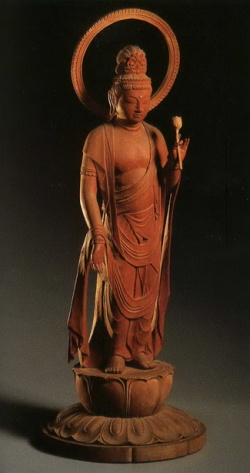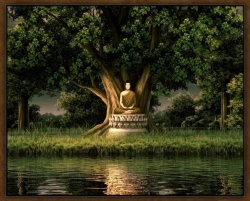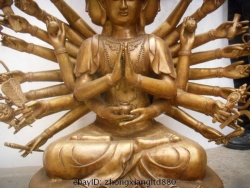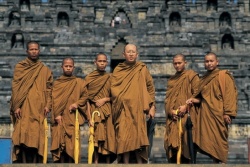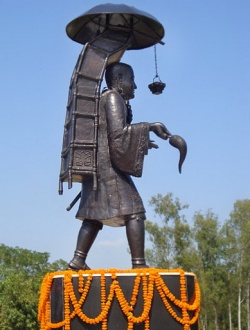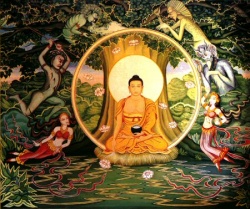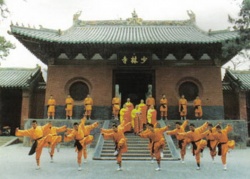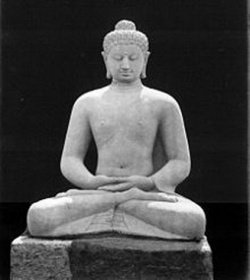Zen
Zen is a school of Mahayana Buddhism that developed in China during the 6th century as Chán. From China, Zen spread south to Vietnam, to Korea and east to Japan.
The word Zen is derived from the Japanese pronunciation of the Middle Chinese word 禪 (dʑjen) (Modern Mandarin: Chán), which in turn is derived from the Sanskrit word Dhyāna, which can be approximately translated as "absorption" or "meditative state".
Zen emphasizes the attainment of Enlightenment and the personal expression of direct insight in the Buddhist teachings. As such, it de-emphasizes mere knowledge of sutras and Doctrine and favors direct understanding through zazen and interaction with an accomplished teacher.
The teachings of Zen include various sources of Mahāyāna thought, especially Yogācāra, the Tathāgatagarbha Sutras and Huayan. The Prajñāpāramitā literature and, to a lesser extent, Madhyamaka have also been influential.
Chinese Chán
Bodhidharma. Woodcut print by Yoshitoshi (Japanese), 1887.
The history of Chán in China can be divided in several periods. Zen as we know it today is the result of a long history, with many changes and contingent factors. Each period had different types of Zen, some of which remained influential, while others vanished.
Although McRae has reservations about the division of Chán-history in phases or periods, he nevertheless distinguishes four phases in the history of Chán:
Proto-Chán (ca. 500-600). In this phase, Chán developed in multiple locations in northern China. It was based on the practice of Dhyana, and is connected to the figures of Bodhiharma and Huike. Its principal text is the Two Entrances and Four Practices, attributed to Bodhidharma.
Early Chán (ca. 600-900). In this phase Chán took its first clear contours. Prime figures are the fifth patriarch Daman Hongren (601–674), his Dharma-heir Yuquan Shenxiu (606?-706), the sixth patriarch Huineng (638–713), antagonist of the quintessential Platform Sutra, and Shenhui (670-762), whose propaganda elevated Huineng to the status of sixth patriarch. Prime factions are the Northern School, Southern School and Oxhead School.
Middle Chán (ca. 750-1000). In this phase developed the well-known Chán of the iconoclastic zen-masters. Prime figures are Mazu Daoyi (709–788), Shitou Xiqian (710-790), Linji Yixuan (d.867), and Xuefeng Yicun (822-908). Prime factions are the Hongzhou school and the Hubei faction ] An important text is the Anthology of the Patriarchal Hall (952), which gives a great amount of "encounter-stories", and the well-known genealogy of the Chán-school.
Song-Dynasty Chán (ca. 950-1300). In this phase Chán took its definitive shape, including the picture of the "golden age" of the Chán of the Tang-Dynasty, and the use of gong-an (公案) for individual study and meditation. Prime figures are Dahui Zonggao (1089–1163), who introduced the Hua Tou practice, and Hongzhi Zhengjue (1091-1157), who emphasized Shikantaza. Prime factions are the Linji school and the Caodong school. The classic gong-an-collections, such as the Blue Cliff Record were assembled in this period , which reflect the influence of the "literati" on the development of Chán. In this phase Chán is transported to Japan, and exerts a great influence on Korean Seon via Jinul.
Neither Ferguson nor McRae give a periodisation for Chinese Chán following the Song-dynasty, though McRae mentions "at least a postclassical phase or perhaps multiple phases".
Spread of Chán
Thiền in Vietnam
Thiền monks performing a service in Huế.
According to traditional accounts of Vietnam, in 580 an Indian Monk named Vinitaruci (Vietnamese: Tì-ni-đa-lưu-chi) travelled to Vietnam after completing his studies with Sengcan, the third patriarch of Chinese Chán. This, then, would be the first appearance of Vietnamese Thiền Buddhism. Other early Vietnamese Chán schools included the Vô Ngôn Thông, which was associated with the teaching of Mazu, and the Thảo Đường, which incorporated nianfo Chanting techniques; both were founded by Chinese monks.
Seon in Korea
Seon Monk in Seoul, South Korea
Seon was gradually transmitted into Korea during the late Silla period (7th through 9th centuries) as Korean monks of predominantly Hwaeom (華嚴) and Consciousness-only (唯識) background began to travel to China to learn the newly developing tradition. Seon received its most significant impetus and consolidation from the Goryeo Monk Jinul (知訥) (1158–1210), who established a reform movement and introduced koan practice to Korea. Jinul established the Songgwangsa (松廣寺) as a new center of pure practice.
Zen in Japan
Sojiji Temple, of the Soto Zen school, Tsurumi-ku, Yokohama, Japan
Zen was not introduced as a separate school until the 12th century, when Myōan Eisai traveled to China and returned to establish a Linji lineage, which eventually perished. Decades later, Nanpo Shōmyō (南浦紹明?) (1235–1308) also studied Linji teachings in China before founding the Japanese Otokan lineage, the most influential and only surviving lineage of Rinzai in Japan. In 1215, Dōgen, a younger contemporary of Eisai's, journeyed to China himself, where he became a disciple of the Caodong master Tiantong Rujing. After his return, Dōgen established the Sōtō school, the Japanese branch of Caodong.
The three traditional schools of Zen in contemporary Japan are the Sōtō (曹洞?), Rinzai (臨済?), and Ōbaku (黃檗?). Of these, Sōtō is the largest, Rinzai is middle, and Ōbaku the smallest. These are further divided into subschools by head temple, with 2 head temples for Sōtō (Sōji-ji and Eihei-ji, with Sōji-ji having a much larger network), 14 head temples for Rinzai, and 1 head temple (Manpuku-ji) for Ōbaku, for a total of 17 head temples. The Rinzai head temples, which are most numerous, have substantial overlap with the traditional Five Mountain System, and include Myoshin-ji, Nanzen-ji, Tenryū-ji, Daitoku-ji, and Tofuku-ji, among others.
Besides these traditional organizations, there are modern Zen organisations which have especially attracted Western lay followers, namely the Sanbo Kyodan and the FAS Society.
Zen in the Western world
See also: Buddhism in the West and Zen in the United States
Although it is difficult to trace when the West first became aware of Zen as a distinct form of Buddhism, the visit of Soyen Shaku, a Japanese Zen Monk, to Chicago during the World Parliament of Religions in 1893 is often pointed to as an event that enhanced its profile in the Western world. It was during the late 1950s and the early 1960s that the number of Westerners, other than the descendants of Asian immigrants, pursuing a serious Interest in Zen began to reach a significant level. Especially Japanese Zen has gained popularity in the West. The various Books on Zen by Reginald Horace Blyth, Alan Watts, Philip Kapleau and D. T. Suzuki published between 1950 and 1975, contributed to this growing Interest in Zen in the West, as did the Interest from beat poets such as Jack Kerouac, Allen Ginsberg and Gary Snyder.
Zen teachings
Though Zen-narrative states that it is a "special transmission outside scriptures" which "did not stand upon words" , Zen does have a rich doctrinal background. Most essential are "the most fundamental teaching [...] that we are already originally enlightened" , and the Bodhisattva ideal, which supplements insight with Karuṇā, Compassion with all Sentient beings.
To point out 'essential Zen-teachings' is almost impossible, given the variety of schools, the extended history of 1500 years, and the emphasis on suchness, reality just-as-it-is, which has to be expressed in daily Life, not in words. But common to most schools and teachings is this emphasis on suchness, the Bodhisattva-ideal, and the priority of zazen.
Zen teachings can be likened to "the finger pointing at the moon". Zen teachings point to the moon, awakening, "a realization of the unimpended interpenetration of the dharmadhatu". But the Zen-tradition also warns against taking its teachings, the pointing finger, to be this insight itself.
The various traditions lay various emphases in their teachings and practices:
There are two different ways of understanding and actually practicing Zen. These two different ways are termed in Chinese pen chueh and shih-chueh respectively. The term pen chueh refers to the belief that one’s mind is from the beginning of time fully enlightened, while shih-chueh refers to the belief that at some point in time we pass from imprisonment in Ignorance and Delusion to a true vision of Zen realization: “Our Enlightenment is timeless, yet our realization of it occurs in time.” According to this belief experiencing a moment of awakening in this Life is of central importance.
Rinzai
The Rinzai-tradition emphasizes Kensho, insight into one's true nature. This is followed by so-called post-Satori practice, further practice to attain Buddhahood.
Other Zen-teachers have also expressed sudden insight followed by gradual cultivation. Chinul, a 12th-century Korean Seon master, followed Zongmi, and also emphasized that insight into our true nature is sudden, but is to be followed by practice to ripen the insight and attain full Buddhahood. This is also the standpoint of the contemporary Sanbo Kyodan, according to whom Kensho is at the start of the path to full Enlightenment.
To attain this primary insight and to deepen it, zazen and Kōan-study is deemed essential. This trajectory of initial insight followed by a gradual deepening and ripening is expressed by Linji in his Three mysterious Gates, and the Four Ways of Knowing of Hakuin. Another example of depiction of stages on the path are the Ten Ox-Herding Pictures which detail the steps on the Path.
Soto
The Sōtō-school has de-emphasized kōans since Gentō Sokuchū (circa 1800), and instead emphasized shikantaza. Dogen, the founder of Soto in Japan, emphasised that practice and awakening cannot be separated. By practicing shikantaza, attainment and Buddhahood are already being expressed. For Dogen, zazen, or shikantaza, is the essence of Buddhist practice.
Gradual cultivation is also recognized by the Caodong-teacher Tozan. The first syllable of his name is part of the word "Soto".
Ōbaku
Sanbo Kyodan
The Sanbo Kyodan combines Soto and Rinzai teachings. It is Japanese lay-organisation which is highly influential in the west via Hakuun Yasutani, Philip Kapleau, Yamada Koun and Taizan Maezumi. Yasutani mentions three goals of Zen: development of concentration (joriki), awakening (Kensho-godo), and realisation of Zen in daily Life (mujodo no taigen). Kensho is stressed , but also post-Satori practice. Yasutani discerns five kinds of Zen:
Bompu Zen, aimed bodily and mental health
Gedo Zen, practices like Dhyana, Yoga and Christian contemplation which are akin to Zen, but not Buddhist
Shojo Zen, the Hinayana, aimed at one's own liberation
Daijo Zen, the Mahayana, aimed at attaining Kensho and the realisation of Zen in daily Life
Saijojo Zen, in which practice is Enlightenment
Zen practice
Zen meditation
Central to Zen-practice is Dhyana or meditation. The Zen tradition holds that in meditation practice, notions of Doctrine and teachings necessitate the creation of various notions and appearances (Skt. saṃjñā; Ch. 相, xiāng) that obscure the transcendent Wisdom of each being's Buddha-nature. This process of rediscovery goes under various terms such as "introspection", "a backward step", "turning-about" or "turning the eye inward".
Zazen
Venerable Hsuan Hua meditating in the Lotus Position. Hong Kong, 1953.
Main article: Zazen
Sitting meditation is called zazen (Jp.: 坐禅, lit. "seated meditation"), and in Chinese it is called zuòchán (坐禅), both simply meaning "sitting Dhyāna". During this sitting meditation, practitioners usually assume a position such as the Lotus position, half-Lotus, Burmese, or seiza postures, using the Dhyāna mudrā. To regulate the mind, awareness is directed towards counting or watching the Breath or put in the energy center below the navel (see also anapanasati). Often, a square or round cushion placed on a padded mat is used to sit on; in some other cases, a chair may be used.
Shikantaza
In the Soto school of Zen, meditation with no objects, anchors, or content, is the primary form of practice. The meditator strives to be aware of the stream of thoughts, allowing them to arise and pass away without interference. Considerable textual, philosophical, and phenomenological justification of this practice can be found throughout Dōgen's Shōbōgenzō, as for example in the "Principles of Zazen" and the "Universally Recommended Instructions for Zazen".
Sesshin
Zen traditions include periods of intensive group meditation in a monastery. While the daily routine in the monastery may require monks to meditate for several hours each day, during this intensive period they devote themselves almost exclusively to the practice of sitting meditation. The numerous 30–50 minute long meditation periods are interleaved with short rest breaks, meals, and sometimes, short periods of work should be performed with the same Mindfulness; nightly sleep is kept to a minimum: 7 hours or less. In modern Buddhist practice in Japan, Taiwan, and the West, lay students often attend these intensive practice sessions, which are typically 1, 3, 5, or 7 days in length. These are held at many Zen centers, especially in commemoration of The Buddha's attainment of Anuttarā SamyaksaṃBodhi. One distinctive aspect of Zen meditation in groups is the use of a flat wooden slat used to keep meditators focused and awake.
Kōan practice
Chinese character for "nothing", Chinese: wú (Japanese: mu). It figures in the famous Zhaozhou's dog Kōan
At the beginning of the Song Dynasty, practice with the Kōan method became popular, whereas others practiced "silent illumination." This became the source of some differences in practice between the Linji and Caodong traditions.
A Kōan, literally "public case", is a story or dialogue, describing an interaction between a Zen master and a student. These anecdotes give a demonstration of the master's insight. Koans emphasize the non-conceptional insight that the Buddhist teachings are pointing to. Koans can be used to provoke the "great Doubt", and test a student's progress in Zen practice.
Kōan-inquiry may be practiced during sitting meditation (zazen), walking meditation (Kinhin), and throughout all the activities of daily Life. Kōan practice is particularly emphasized by the Japanese Rinzai school, but it also occurs in other schools or branches of Zen depending on the teaching line.
The Zen student's Mastery of a given Kōan is presented to the teacher in a private interview (referred to in Japanese as dokusan (独参), daisan (代参), or sanzen (参禅)). While there is no unique answer to a Kōan, practitioners are expected to demonstrate their understanding of the Kōan and of Zen through their responses. The teacher may approve or disapprove of the answer and guide the student in the right direction. The interaction with a Zen-teacher is central in Zen, but makes Zen-practice, at least in the west, also vulnerable to misunderstanding and exploitation.
Zen Chanting and liturgy
A practice in many Zen monasteries and centers is a daily liturgy service. Practitioners chant major sutras such as The Heart Sutra, chapter 25 of the Lotus Sutra (often called the "Avalokiteshvara Sutra"), the Song of the Jewel Mirror Awareness, the Great Compassionate Heart Dharani (Daihishin Dharani), and other minor mantras.
The Butsudan is the altar in a monastery where offerings are made to the images of The Buddha or Bodhisattvas. The same term is also used in Japanese homes for the altar where one prays to and communicates with deceased family members. As such, reciting liturgy in Zen can be seen as a means to connect with the Bodhisattvas of the past. Liturgy is often used during Funerals, memorials, and other special events as means to invoke the aid of supernatural powers.
Chanting usually centers on major Bodhisattvas like Avalokiteshvara (see also Guan Yin) and Manjusri. According to Mahayana Buddhism, Bodhisattvas are beings who have taken vows to remain in Samsara to help all beings achieve liberation from the cycle of birth, Death and Rebirth. Since the Zen practitioner's aim is to walk the Bodhisattva path, Chanting can be used as a means to connect with these beings and realize this ideal within oneself.
Lay services
Though in western Zen the emphasis is on zen-meditation, and the application of Zen-teachings in daily Life, Japanese Zen also serves a function in public religion. Funerals play an important role as a point of contact between the monks and the laity. Statistics published by the Sōtō school state that 80 percent of Sōtō laymen visit their temple only for reasons having to do with Funerals and Death, while only 17 percent visit for spiritual reasons and a mere 3 percent visit a Zen priest at a time of personal trouble or crisis.
Zen scripture
The role of scripture in Zen
Contrary to the popular image, literature does play a role in the Zen-training. Zen is deeply rooted in the teachings and doctrines of Mahāyāna Buddhism. Unsui, Zen-monks, "are expected to become familiar with the classics of the Zen canon". A review of the early historical documents and literature of early Zen masters clearly reveals that they were well versed in numerous Mahāyāna Buddhist sūtras.
Nevertheless Zen is often pictured as anti-intellectual. This picture of Zen emerged during the Song Dynasty (960–1297), when Chán became the dominant form of Buddhism in China, and gained great popularity among the educated and literary classes of Chinese society. The use of koans, which are highly stylized literary texts, reflects this popularity among the higher classes. The famous saying "do not establish words and letters", attributed in this period to Bodhidharma ,
...was taken not as a denial of the recorded words of The Buddha or the doctrinal elaborations by learned monks, but as a warning to those who had become confused about the relationship between Buddhist teaching as a guide to the truth and mistook it for the truth itself.
What the Zen tradition emphasizes is that Enlightenment of The Buddha came not through conceptualization, but rather through direct insight. }} But direct insight has to be supported by study and understanding (hori of the Buddhist teachings and texts. . Intellectual understanding without practice is called yako-zen, wild fox Zen", but "one who has only experience without intellectual understanding is a zen temma', "Zen Devil"".
Grounding Chán in scripture
The early Buddhist schools in China were each based on a specific Sutra. At the beginning of the Tang Dynasty, by the time of the Fifth Patriarch Hongren (601–674), the Zen school became established as a separate school of Buddhism. It had to develop a doctrinal tradition of its own to ascertain its position, and to ground its teachings in a specific Sutra. Various Sutra's were used for this, even before the time of Hongren: the Śrīmālādevī Sūtra (Huike) , Awakening of Faith (Daoxin) ], The Lankavatara Sutra (East Mountain School) , The Diamond Sutra (Shenhui) , the Platform Sutra. Subsequently, the Zen tradition produced a rich corpus of written literature which has become a part of its practice and teaching. Other influential sutras are the Vimalakirti Sutra , Avatamsaka Sutra , The Shurangama Sutra , and the Mahaparinirvana Sutra.
Zen literature
The Zen-tradition developed a rich textual tradition, based on the interpretation of the Buddhist teachings and the recorded sayings of Zen-masters. Important texts are the Platform Sutra (8th century), attributed to Huineng ; the Chán transmission records, teng-lu , such as The Records of the Transmission of the Lamp (Ching-te ch'uan-teng lu), compiled by Tao-yün and published in 1004 ; the "yü-lü" genre consisting of the recorded sayings of the masters, and the encounter dialogues; the koan-collections, such as the "Gateless Gate" and the "Blue Cliff Record". 'and Dogen's Shobogenzo.
Zen organisation and institutions
Main articles: Zen organisation and institutions, Zen ranks and hierarchy, Dharma transmission, and Zen lineage charts
Religion is not only an individual matter, but "also a collective endeavour". Though individual experience and the iconoclastic picture of Zen are emphasised in the western world, the Zen-tradition is maintained and transferred by a high degree of institutionalisation and hierarchy. In Japan, modernity has led to Criticism of the formal system and the commensement of lay-oriented Zen-schools such as the Sanbo Kyodan and the Ningen Zen Kyodan. How to organize the continuity of the Zen-tradition in the west, constraining charismatic authority and the derailment it may bring on the one hand , and maintaining the legitimacy and authority by limiting the number of authorized teachers on the other hand , is a challenge for the developing Zen-communities in the west.
Zen narratives
The Chán of the Tang Dynasty, especially that of Mazu and Linji with its emphasis on "shock techniques", in retrospect was seen as a golden age of Chán. This picture has gained great popularity in the west in the 20th century, especially due to the influence of D.T. Suzuki, and further popularized by Hakuun Yasutani and the Sanbo Kyodan. This picture has been challenged, and complemented, since the 1970s by modern scientific research on Zen.
Modern scientific research on the history of Zen discerns three main narratives concerning Zen, its history and its teachings: Traditional Zen Narrative (TZN), Buddhist Modernism (BM), Historical and Cultural Criticism (HCC). An external narrative is Nondualism, which claims Zen to be a token of a universal nondualist essence of religions.
